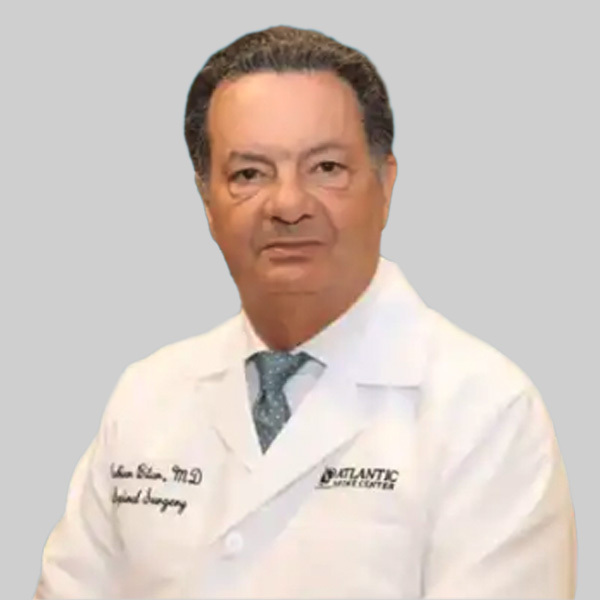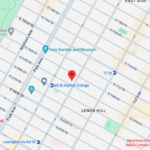Chronic back pain affects roughly 8 percent, or 16 million, of adult Americans. But the condition strikes older adults in even higher numbers — and that’s likely because of degenerative disc disease in the lower back.
Due to the nature of the condition and how it progresses, degenerative disc disease in the lower back and neck hits older adults over 40 especially hard, making walking and doing everyday chores extremely painful and difficult to accomplish at a time when they may be dealing with other health issues..
Yet care can be found in New York City. The expert team of orthopedists at New York Bone & Joint Specialists stands ready to help older people manage the condition. We take a comprehensive approach, starting with conservative treatments and surgical intervention only when necessary. In addition, we’ll show you ways to modify your lifestyle and exercise routine so you can live a full, active life free of pain.
If lower back pain caused by degenerative disc disease is hampering your quality of life, contact New York Bone & Joint Specialists. Our team will tailor a treatment plan and therapies just for your needs and lifestyle.
What is degenerative disc disease?
Calling degenerative disc disease a “disease” is somewhat misleading. It’s a condition that’s largely due to the natural aging process. Almost everyone will experience disc degeneration as they age.
To understand degenerative disc disease, let’s first look at what a disc is. Between each bony vertebra in your spine sits an oval disc covered by a tough exterior that protects a fluid-filled interior. These discs cushion the vertebrae so the bones don’t rub together when you move and rotate your back or neck. Your spine gets its mobility from the discs.
As we age, the fluid inside the disc dries up. With less fluid, the disc thins and can no longer serve as a cushion between the vertebrae, leading to the bones rubbing against each other and causing pain. As the discs shrink, you may lose a few inches in height, too.
As the disc weakens, tears become more common. A tear like this is called a herniated disc. When that happens, the ruptured disc places additional strain on the spinal cord or nerves. Disc tears can occur due to an accident, an awkward twisting of the spine, repetitive motions, or a hard hit during a sporting event.
Most people experience at least some disc degeneration as they age. However, it’s a progressive disease, meaning the pain and symptoms may increase over time, usually in four stages:
- Stage 1: The discs have started to degenerate, but any symptoms are mild.
- Stage 2: Continued dehydration of the discs, resulting in decreased flexibility. Neck or back pain intensifies.
- Stage 3: Spinal stenosis may develop as the spine attempts to stabilize itself. The pain becomes more severe.
- Stage 4: At this point, the discs collapse and the bones rub together, pinching a nerve and leading to greater pain.
Degenerative disc disease in the lower back: Understanding the condition
Degenerative disc disease occurs most often in the lower back (lumbar spine) and neck. But by far, degenerative disc disease in the lower back accounts for the vast majority of cases. That’s where the largest bones in the back are located. Medically, those vertebrae are termed L1 to L5.
Because we use our spine to bend, lift, and do everyday tasks, the area is susceptible to degeneration due to all these repetitive movements.
Another factor contributing to degenerative disc disease in the lower back is posture. Slouching while standing strains the lower spine, which can wear down the discs quicker than the normal aging process. Hunching over when seated also puts pressure on the discs of the lower back. Smoking and a sedentary lifestyle can also exacerbate the condition.
Degenerative disc disease in lower back symptoms
Degenerative disc disease in the lower back comes with several distinct symptoms. Severity often varies between people based on lifestyle, age, and genetics.
Primary symptoms:
- Pain in the lower back that is chronic or intermittent
- Pain worsens when seated, bending, or lifting
- Sharp pain on occasion
- Lying flat on your back can ease the pain
- Morning stiffness
- Pain lessens when walking or changing positions
Secondary symptoms:
As the condition progresses, you may experience secondary symptoms:
- Muscle spasms from a pinched nerve
- Pain in the hips or buttocks (referred pain)
- Occasional leg pain or weakness
When you experience referred pain in the hips or buttocks, you may need a medical evaluation. Degenerative disc disease is a progressive condition. If not treated early, it can lead to other serious conditions of the spine, including adult scoliosis, spinal stenosis, and a herniated disc, in addition to worsening pain.
“Degenerative disc disease is a natural part of aging, but that doesn’t mean you have to accept chronic pain as inevitable. We offer innovative treatments that can slow progression and significantly improve your quality of life without major surgery.” – Dr. Leon Popovitz, MD, Co-Founder of New York Bone & Joint.
What causes degenerative disc disease?
Degenerative disc disease in the lower back stems from these main causes:
Age: The primary cause of degenerative disc disease is the natural aging process, which thins the jelly-like disc material.
Genetics: The condition tends to run in families.
Lifestyle: Tobacco use, obesity, and lack of exercise all contribute to disc damage.
Occupation: People who sit for long periods put stress on the discs of the lower spine. Daily heavy lifting can wear down the discs over time, as well.
Trauma: A bad fall or injury can wrench the spine out of place and eventually lead to disc degeneration.
Gender: Women are more prone to disc degeneration than men.
Prevention strategies:
There are several steps you can take to lessen the risk of disc degeneration. Including:
- Stop smoking
- Exercise
- Maintain a healthy weight
- Avoid alcohol
- Eat a varied and vitamin-rich diet, including ample calcium.
How is degenerative disc disease diagnosed?
A clinical diagnosis of degenerative disc disease must be made to rule out other conditions. To diagnose the condition, one of our top-rated spinal orthopedic specialists in New York will:
Physical exam: An orthopedic will evaluate your pain level and muscle strength. He or she may use a reflex hammer to test your nerve function. If you exhibit little to no reaction, you may have a compressed nerve.
Imaging tests: X-rays, CT scans, and an MRI may be ordered to determine which discs are out of alignment or damaged. This will provide the physician with a better understanding of what is causing your symptoms.
Discography: In a discography, a contrast dye is injected into the affected disc to produce a pain response. To pinpoint the damaged disc even further, the dye is injected into nearby discs, too. A negative response means those discs are not affected.
Treatment options for degenerative disc disease
The primary treatment mode for degenerative disc disease relies on conservative methods combining medication and physical therapy to manage pain. Here are some of those methods:
Non-surgical:
Anti-inflammatories: Non-steroidal anti-inflammatories available in drugstores (ibuprofen, naproxen, aspirin) can ease inflamed tissue in the spine. If needed, your doctor may prescribe a stronger anti-inflammatory or corticosteroid. But those are only for temporary use.
Physical therapy and exercise: Physical therapy and exercises that target the core muscles (back, abdomen, upper thighs, and buttocks) add extra support to the spine.
Muscle relaxants: To relieve painful muscle spasms, your doctor may prescribe a muscle relaxant. However, the medication should only be used for a week or two until the spasms stop.
Injections: An injection containing a corticosteroid is injected into the epidural region, the fluid-filled area around the spinal cord, to reduce pain and inflammation in the painful disc.
Surgical options
If conservative therapies fail to bring about pain relief or improve mobility, your doctor may consider surgery. Surgery for degenerative disc disease can be one of these options. Your doctor at New York Bone & Joint Specialists will discuss this with you.
Spinal fusion: If the disc is severely compromised, the surgeon will remove it and fuse the vertebrae above and below it together to lock the spine in alignment. Because the affected disc is removed, it can no longer irritate nearby nerves and cause pain.
Artificial disc replacement: Typically recommended for patients under 65 instead of spinal fusion, the damaged disc is removed through an incision. A prosthetic “spacer” is then placed between the two vertebrae to stabilize the spine.
Lumbar discectomy: Through a small incision, the surgeon accesses the area around the damaged disc. Using tiny instruments and microscopes, the surgeon then removes the damaged portion of the disc that’s pressing on a nerve.
Depending upon the type of surgery, you can either go home the same day or remain in the hospital for a day or two. Full recovery may take several weeks.
Living with degenerative disc disease in lower back
Although degenerative disc disease in the lower back is a progressive, chronic condition, many people live active lives with it. Simple adjustments in their home and work environments, as well as lifestyle modifications, can alleviate the pain and mobility issues associated with the condition.
At New York Bone & Joint Specialists, we create comprehensive treatment plans that aim to target current pain and lessen discomfort from the long-term condition. Although there is no cure or reversal for degenerative disc disease, we can help you find ways to reduce pain and increase mobility.
We look at the best exercises for degenerative disc disease in the lower back and how we can incorporate these stretches into your daily routine.
Exercises for degenerative disc disease work in unison with other conservative treatment options:
Hot and cold therapy: Alternating cold and hot compresses can reduce pain. The cold reduces inflammation and swelling associated with degenerative disc disease in the lower back, while the heat rushes blood to the soft tissue to help it heal.
Over-the-counter pain medications: Non-steroidal anti-inflammatories (Advil, Aleve, Excedrin) as well as acetaminophen (Tylenol) offer quick pain relief.
Gentle stretching and movement: Strenuous exercise should be avoided, but less strenuous activities, such as walking, can ease discomfort. Easy stretches that don’t strain the back can loosen tense muscles and reduce pain.
Regular exercise: Staying active is the best way to manage the pain of degenerative disc disease in the lower back long-term. You may not think working out with an achy back is good for you, but without it, your muscles atrophy and cannot support the spine.
Exercise strengthens and increases flexibility in the muscles supporting the spine, reducing the chance of further disc degeneration.
Advanced treatment options for degenerative disc disease
Conservative therapy and surgery aren’t your only treatment options for degenerative disc disease. Our top-rated spinal care doctors can talk to you about some alternative therapies if conservative treatments have failed and you don’t want to undergo surgery.
Regenerative medicine
An innovation in medicine, regenerative medicine uses the body’s cells to heal injuries and damaged tissue. Using the patient’s cells limits the chance of rejection.
Platelet Rich Plasma (PRP): Blood drawn from the patient is concentrated into a solution of his or her cells, which is injected into the patient’s affected area. The process can be done in an office visit.
Minimally invasive procedures: One of the most popular is an injection of a corticosteroid into the epidural region of the spine to immediately reduce pain and inflammation.
Why choose New York Bone & Joint Specialists for degenerative disc disease treatment?
For decades, New York Bone and Joint Specialists has been recognized as a leading expert in back and neck care. Our patients consistently choose us for their spinal conditions because:
- Holistic Joint Health: We prioritize the long-term health and healing of your joints, understanding their crucial role in an active life.
- Comprehensive Care: Our world-class joint specialists provide supportive guidance through every stage of your journey, from accurate diagnosis to full recovery, for a wide array of conditions, including degenerative disc disease.
- Non-Surgical Success: In over 90% of cases, our orthopedic treatments effectively resolve issues without the necessity of surgery.
- Commitment to Recovery: We are dedicated to your complete recovery, employing conservative methods as our first approach and providing expert surgical care only when essential.
Our expert spine specialists in NYC
New York Bone & Joint Specialists is founded on a philosophy of preservation. This approach, prioritizing the body’s structures for long-term spinal health, results in 90% of our patients recovering from degenerative disc disease and other orthopedic conditions without the need for surgery.
Our dedicated team of orthopedic doctors, surgeons, physical therapists, and support staff is committed to providing exceptional care and ensuring the lasting health and function of your joints, offering peace of mind to every patient.
The expert team of spine specialists here in New York has decades of experience treating a range of back and neck problems, mobility issues, and injuries.
Start your journey to better spine health today
Degenerative disc disease doesn’t have to halt your lifestyle. The expert orthopedists at New York Bone & Joint Specialists offer the latest in treatment methods to reduce your back pain. Book today.
Degenerative Disc Disease: FAQs
Is degenerative disc disease serious?
Degenerative disc disease is a natural part of aging and nothing serious. Many people experience no pain from the condition. But if you do, physical therapy, medications, lifestyle changes, and other non-surgical therapies can effectively manage the pain.
What are the best exercises for degenerative disc disease in the lower back?
In general, the best exercises for degenerative disc disease in the lower back are low-impact and gentle on the spine. A daily walk, a bike ride, or a swim are the top exercises for lower back degenerative disc pain.
Avoid activities such as jogging, weightlifting, and contact sports that can wrench the spine out of position and put too much pressure on the back. As with any activity, if you feel intense pain, stop and rest.
How can I get pain relief for degenerative disc disease in my lower back?
For quick pain relief for degenerative disc disease in the lower back, try hot/cold therapy, OTC pain relievers, and gentle stretching. Physical and occupational therapy, prescription medications, minimally invasive treatments such as steroid injections, and potentially surgery provide longer-term freedom from pain.
Can degenerative disc disease get worse?
Yes, degenerative disc disease is a progressive condition, meaning it can worsen over time without treatment. Treating it early at the first sign of back soreness and stiffness is your best chance for avoiding persistent and increasing pain.
What should I avoid with degenerative disc disease?
Degenerative disc disease is exacerbated by any exercise or motion that twists the spine out of its normal alignment or strains the back. That includes weightlifting, jumping in basketball, and jogging on hard surfaces.
Is surgery necessary for degenerative disc disease?
Conservative therapy has a high success rate. Surgery is rarely recommended for degenerative disc disease and is reserved for cases where non-surgical treatments have been unsuccessful in reducing pain.
Can I exercise with degenerative disc disease in my back?
Yes, you can exercise with degenerative disc disease. It can reduce pain and improve your mobility. But stick to low-impact workouts like walking, swimming, and biking. Gentle stretching is also recommended. Build up your core muscles with exercise to support your spine.
How long does degenerative disc disease pain last?
Unfortunately, once the disc degeneration begins, it cannot be reversed. It may start as mild pain and then increase as the disc continues to shrink. However, with exercise, lifestyle changes, and treatment, the pain becomes manageable and you can avoid flare-ups.
What’s the difference between degenerative disc disease and a herniated disc?
In degenerative disc disease, the fluid-filled sac between the vertebrae loses fluid due to aging, but remains intact. When the disc becomes herniated, the sac breaks open and the fluid leaks out.
Can you live a normal life with degenerative disc disease?
Yes! With treatment, physical therapy, and adaptations in your home and work life, you can live a full, active life without back pain.










